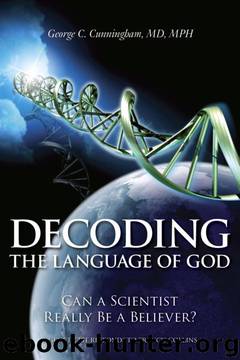Decoding the Language of God: Can a Scientist Really Be a Believer? by George C. Cunningham

Author:George C. Cunningham [Cunningham, George C.]
Language: eng
Format: epub
Published: 2010-02-09T17:22:00+00:00
The Bible is the source of people's belief in miracles, which supposedly demonstrates Jesus' divine nature. I discuss miracles in detail in chapter 3, so I will deal here only with the most essential Christian miracle, the Resurrection. Many books have been written on this topic, some of which I have read. In them, skeptics propose plausible, natural explanations for the details of the Resurrection story, as reported in the Bible. Almost all of these authors, critics and defenders, assume that most of the biblical text and descriptions are reliable. Defenders, mostly academic theologians, try to discredit these alternative explanations based on their own interpretations of the biblical texts and to argue that the best explanation for the Resurrection is a supernatural miracle. My analysis after sampling this literature is that this is a miracle story based partially on what probably happened and partially on fictional embellishments needed to create a miracle story. Jesus' followers constructed this legend to convince other people that Jesus was God incarnate. In fact, there is no evidence of this momentous event outside of the story in the Bible.
The first biblical text to claim Jesus rose from the dead is the Epistles of Paul. He gives no details of the events that were later described by Mark, Matthew, Luke, and John. Paul says in his Resurrection text, "For I delivered unto you first of all that which I also received, how that Christ died for our sins according to the scriptures" (1 Corinthians 15:3). This establishes the fact that Paul's belief is not based on eyewitness evidence but on second- and thirdhand reports. Some defenders claim, without any textual evidence, that Paul means he was provided information from Peter and James when he first visited them in Jerusalem three years after the event. That is still secondhand, even if true.
So Paul did not contribute evidence of his own experience of Jesus' appearances after death. It is almost certain that Paul had an attack of temporal lobe epilepsy on the road to Damascus and experienced visual and auditory hallucinations presumably sometime after Jesus' death (Acts 9:3-9). He suddenly fell to the ground and was blinded by a bright light that was not seen by his companions. He had an auditory hallucination, hearing what he believed to be the voice of Jesus. There is no description of the appearance of Jesus, either as a ghostly spirit or as a flesh and blood human being. Paul was in a postseizure state for three days before his sight returned. This was a private, subjective experience, and none of Paul's companions saw Jesus.
Paul also mentions that Jesus "was seen of above by five hundred of the brethren at once" (1 Corinthians 15:6). Again, it is probable that he did not witness this event but believed those who told him about it. There are no details about where or when this alleged event took place. Almost certainly there was no such event, or if it occurred it was another example of the well-established phenomenon of mass hallucination.
Download
This site does not store any files on its server. We only index and link to content provided by other sites. Please contact the content providers to delete copyright contents if any and email us, we'll remove relevant links or contents immediately.
Enlightenment Now: The Case for Reason, Science, Humanism, and Progress by Steven Pinker(7228)
A Journey Through Charms and Defence Against the Dark Arts (Harry Potter: A Journey Through…) by Pottermore Publishing(4781)
The Immortal Life of Henrietta Lacks by Rebecca Skloot(4525)
A Journey Through Divination and Astronomy by Publishing Pottermore(4344)
Elon Musk by Ashlee Vance(4028)
Origin Story: A Big History of Everything by David Christian(3648)
COSMOS by Carl Sagan(3554)
Alchemy and Alchemists by C. J. S. Thompson(3449)
Bad Pharma by Ben Goldacre(3355)
Enlightenment Now by Steven Pinker(3335)
Shadow of Night by Deborah Harkness(3302)
Inferior by Angela Saini(3276)
A Mind For Numbers: How to Excel at Math and Science (Even If You Flunked Algebra) by Barbara Oakley(3217)
Origin Story by David Christian(3147)
The Code Book by Simon Singh(3074)
Signature in the Cell: DNA and the Evidence for Intelligent Design by Stephen C. Meyer(3071)
The Elements by Theodore Gray(2998)
A Brief History of Time by Stephen Hawking(2960)
A Journey Through Potions and Herbology (A Journey Through…) by Pottermore Publishing(2826)
